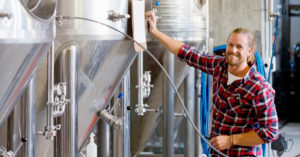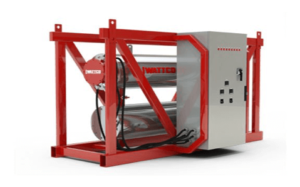Heat Transfer in the Food Processing Industry
Last updated on March 11th, 2022 at 05:38 pm
 One of the common engineering disciplines used in food processing is heat transfer. It plays a pivotal role in enhancing the safety, nutritional and sensory aspects of the product. There are multiple sub-processes like sterilization, freezing, preservation, and freezing in the food processing industry. All of which rely on delivering the right and consistent quality to its customers.
One of the common engineering disciplines used in food processing is heat transfer. It plays a pivotal role in enhancing the safety, nutritional and sensory aspects of the product. There are multiple sub-processes like sterilization, freezing, preservation, and freezing in the food processing industry. All of which rely on delivering the right and consistent quality to its customers.
One of the challenges of heat transfer in the food and beverage industry is steady and unsteady heat transfer taking place in different sub-processes. As well as heating raw materials with irregular shapes, physical properties which vary during the process cycle, non-uniform and sometimes variable consistency.
Because of the non-Newtonian nature of the foods, their thermal behavior has always remained a challenge to model and a better engineering understanding to solve the unsteady heat transfer differential equations by analytical solution with simplifying assumptions is required.
Role of heat exchangers in food processing
Whether the product is UHT treated milk, meatballs in a sauce, or chocolate ice cream just about every food process involves a heat exchanger. Heat treatments or heat transfer processes offer potential exceptions to this, but there is still a heat transfer involved.
The type of heat exchanger depends on multiple factors related to the physical attributes of the product. For example, the size of particulate matter, viscosity, thermal conductivity, thermal diffusivity, and specific heat.
More complex products with irregular raw materials sizes require a more complex heat exchanger design to ensure the target flow characteristics. The aim is to have a more efficient heat transfer for a consistent and high-quality product each time. The most common shapes of heat exchangers used in the food industry are tubular or plate-type heat exchangers. The design emphasizes preventing fouling which is one of the fundamental issues in food processing.
Fouling
Fouling occurs when unwanted material deposits form on the heat transfer surfaces. This results in the formation of an insulation layer, thus reducing the effectiveness of the heat transfer process. This adversely affects flow performance and pressure drop.
Common types of fouling include scaling caused by:
- Calcium carbonate
- Calcium sulfate
- Silicates
- Sedimentation
- Biological growth
- Incrustation
One revolutionary design in heat exchangers used in the food processing industry that has resolved the issues of weld leakages and fouling is the Tetra Pak-designed tubular heat exchanger. In a traditional heat exchanger the parts are welded together, when the metal heats up and cools down it results in thermal stresses which in turn results in cracking of welded joints and corrosion over the period, this increases the risk of food contamination. In a Tetra Pak heat exchanger, this is replaced by non-welded floating joints.
Types of heat exchangers in the food processing industry
Common heat exchangers used in food processing are:
Tubular heat exchanger
This is the simplest heat exchanger type. It consists of a double-walled pipe with one fluid passing through the center tube and the second fluid passing through the annulus between the two tubes. There are also triple-walle d pipes where processed fluid passes through an intermediate passage and heating and cooling fluids pass through other annular spaces so that processed fluid is surrounded on both sides. Although the capital cost of these exchangers is low, they are less common in the food processing industry.
d pipes where processed fluid passes through an intermediate passage and heating and cooling fluids pass through other annular spaces so that processed fluid is surrounded on both sides. Although the capital cost of these exchangers is low, they are less common in the food processing industry.
VAT
Another simple heat exchanger with a double-walled tank. The annular space contains heating fluid, and they are more commonly used for batch pasteurization. Sometimes an agitator is also provided for the movement of product over the heat transfer surfaces.
Plate heat exchanger
This is the most common heat exchanger in the food processing industry. It consists of thin plates stacked together to provide high heat transfer surface area within a small volume. Plate heat exchangers offer low capital cost and easy maintenance due to the ease of disassembly and the ability to use cleaning-in-place methods.
Scraped surface heat changer
This is used when processed fluid is highly viscous and the risk of lumping is high. It consists of a double-walled pipe exchanger with a central rotating shaft. The shaft removes any excess buildup of material from the inner wall of the pipe. This reduces fouling of the highly viscous fluids.
Heat transfer fluids
Choosing the right heat transfer fluids is an important consideration for the food processing industry. Of particular challenge are the prohibition of steam in some cases, and the absence of steam in others, all while requiring safe and efficient heat transfer to prevent contamination.
The heat transfer fluids used in food processing facilities are certified as NSF HT-1 food grade to meet the operational requirements for incidental food contact. These could be high flash food grade heat transfer fluids where the operating temperature must be below the flashpoint of the fluid. Usually, their operating range is between 15˚C to 340˚C. Food grade low-temperature fluids can also act as cleaners with operating ranges between -40˚C to 232˚C with minimal odor and lower varnishing tendencies.
While selecting the right liquid phase and vapor phase heat transfer fluid for the application it’s important to make sure that the fluid is engineered to resist solids formations, prevents system fouling, and provide high-temperature thermal stability.
NSF HT1 is an NSF registration program that is an international resource for evaluating and registering food-grade heat transfer fluids.
Impact of heating on fats and oils
Heat transfer for heating the vegetable oil presents a unique set of challenges. There are risks of scorching the oil and the formation of fatty acids. A circulation heater with an automated temperature control system is a common solution to mitigate these risks. Circulation heaters have nozzles on both ends and a flanged electric immersion heater for indirect heating of the process fluid. Usually, for vegetable oil, the electric immersion heater uses stainless steel sheath material and low power density to prevent scorching of the vegetable oil and to maintain the right viscosity.
